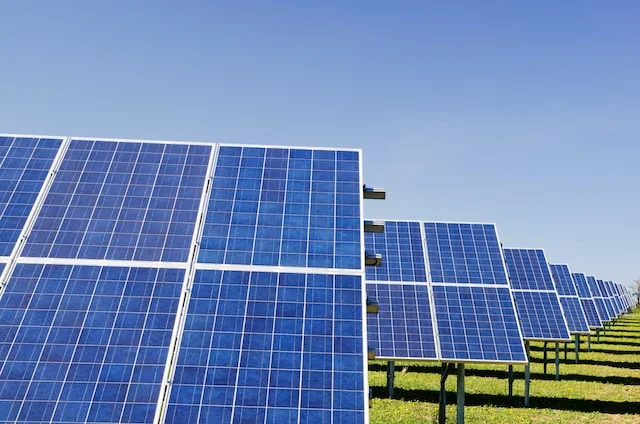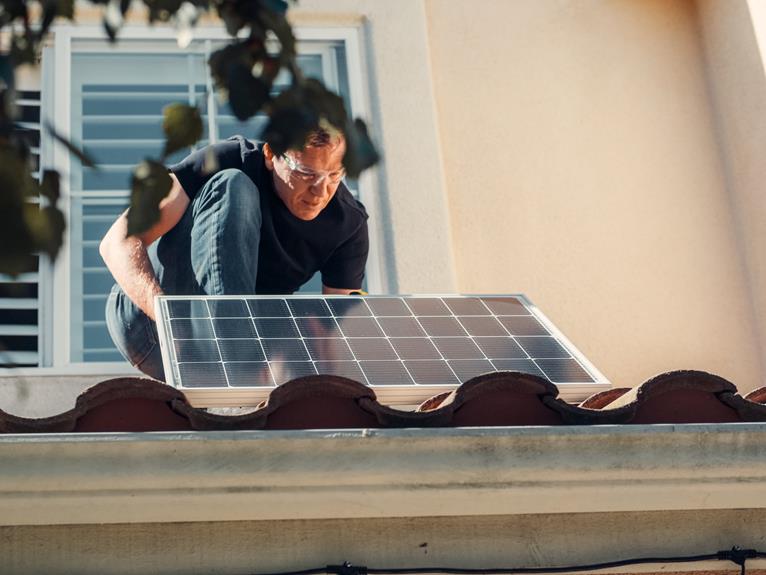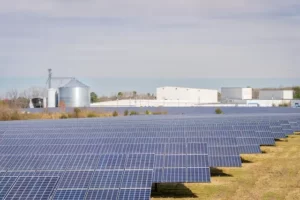
So, you think you’ve heard all there is to know about solar energy grid integration, right?
Well, think again.
Schneider Electric has unveiled 9 game-changing solutions that are set to revolutionize the way we integrate solar energy into the grid. These cutting-edge technologies are not only reshaping the energy landscape but are also addressing some of the most pressing challenges facing the industry today.
But how exactly are these solutions transforming the future of solar energy?
Stay tuned to uncover the groundbreaking innovations that are shaping the future of sustainable energy integration.
Key Takeaways
- A holistic approach and active network management are essential for efficient grid integration of solar energy.
- Module-level power electronics and distributed architecture optimize the performance and safety of solar PV systems.
- Data and AI enhance the management of energy storage systems, improving overall performance and safety.
- Smart grid technologies enable bi-directional energy flow, empowering individuals to sell excess solar energy and optimize energy distribution.
Understanding Grid Integration Challenges
Understanding the grid integration challenges requires a holistic approach that considers the management of multi-energy delivery, including green hydrogen, within the control room of the future. As the grid evolves, active network management plays a pivotal role in enabling flexible customer connection contracts and new grid services to tackle integration challenges.
This means that customers can have more control over their energy usage and production, fostering a deeper connection between energy providers and consumers. Furthermore, the electrification of transportation presents a significant challenge and opportunity in grid integration.
Orchestration of electric vehicle (EV) charging is essential to facilitate the widespread adoption of electric vehicles. Transparent and flexible grids are crucial to support the increasing demand for EV charging infrastructure. By embracing solutions like EcoStruxure DERMS for grid optimization and smart charging infrastructure, the grid can accommodate the prosumer and electrification revolutions.

Ultimately, understanding and addressing these challenges is vital to ensuring a seamless transition to a sustainable, electrified transportation system while enhancing the overall customer experience.
| Solution | Description |
|---|---|
| Grid-Tied Solar System | A solar energy system that is connected to the electric grid. It allows excess electricity generated by the solar panels to be fed back into the grid, reducing reliance on traditional power sources and potentially earning credits or compensation from the utility company. |
| Microgrid | A localized energy system that can operate independently or in conjunction with the main power grid. It integrates solar energy generation with other renewable sources, energy storage systems, and smart grid technologies to provide reliable and sustainable power. |
| Energy Storage Systems | Battery-based systems that store excess solar energy for later use. These systems can be used to provide backup power during grid outages, optimize energy consumption, and enable time-shifted usage of solar energy, reducing dependence on the grid during peak hours. |
| Smart Grid Technologies | Advanced technologies and communication systems that enable efficient monitoring, control, and management of electricity generation, distribution, and consumption. They facilitate the integration of solar energy into the existing grid infrastructure. |
| Power Electronics and Inverters | Devices that convert DC power generated by solar panels into AC power compatible with the electrical grid. They ensure efficient energy conversion, voltage regulation, and synchronization with the grid, enabling seamless integration of solar energy into the grid. |
| Grid Management and Control Systems | Software and hardware systems that monitor and manage the flow of electricity within the grid. They optimize grid operation, balance supply and demand, and enable effective integration of solar energy by coordinating generation, distribution, and consumption activities. |
| Grid Interconnection Standards | Standards and guidelines that define technical requirements for connecting solar energy systems to the grid. They ensure safe and reliable operation, protection against voltage fluctuations, and compliance with regulatory policies for grid integration of renewable energy. |
| Demand Response Programs | Programs that incentivize consumers to adjust their electricity usage in response to grid conditions and fluctuations in supply. These programs can encourage the use of solar energy during peak generation periods and help stabilize the grid by balancing supply and demand. |
| Distributed Energy Resource Management | Systems that optimize the deployment and operation of distributed energy resources, including solar power, within a specific area or region. They enable efficient utilization of solar energy at the local level and facilitate coordination with the main grid for enhanced integration. |
| Grid Integration Consulting Services | Professional services offered by experts in the field of solar energy grid integration. They provide guidance, assessment, planning, design, and implementation support to utilities, businesses, and organizations seeking to integrate solar power into their existing grid infrastructure. |
Enhancing Energy Storage Capabilities
To enhance energy storage capabilities, you can leverage the advancements in PV and ESS technology, building on the foundation of active network management and flexible grid services. Here are some key strategies to enhance energy storage capabilities:
- Increased DC Voltage: By utilizing higher DC voltage in PV inverters, you can achieve greater density and reliability in energy storage solutions, thereby maximizing the efficiency of the overall system.
- MLPE Control: Module-level power electronics (MLPE) provide refined control over individual PV modules, ensuring safer and more intelligent PV systems. This enhances the overall performance and safety of energy storage solutions.
- String Energy Storage: The adoption of distributed architecture, modular design, and innovative technologies in string energy storage optimizes investments and reliability, making energy storage systems more efficient and adaptable.
- Cell-Level Refined Management: Leveraging data and AI for cell-level management in energy storage systems enhances the efficiency and safety of PV systems, contributing to a more sustainable and reliable energy infrastructure.
Implementing Smart Grid Innovations
Now, let’s talk about the exciting advancements in smart grid technology and the benefits it brings.
Smart Grid Benefits
Smart grid benefits can revolutionize the way we manage and utilize renewable energy sources, particularly in the integration of solar power within existing power grid infrastructure. Consider the following benefits of smart grid technologies:
- Efficient utilization and management of renewable energy sources within the existing power grid infrastructure.
- Bi-directional energy flow enables homeowners to sell excess solar energy back to the grid.
- Distributed energy management systems optimize energy distribution, ensuring efficient load balancing and promoting widespread adoption of solar energy.
- Empowerment of individuals by giving them control over their energy consumption and production, contributing to a more sustainable and efficient energy landscape.
These benefits signify a crucial step towards achieving a more accessible, reliable, and sustainable energy future through the integration of smart grid technologies with renewable energy sources such as solar power.
Technology Advancements
With smart grid benefits revolutionizing the management and utilization of renewable energy sources, the implementation of technology advancements such as EcoStruxure for Renewables and AirSeT pure air medium voltage switchgear is integral to further enhancing the grid integration of solar energy.
These innovations play a crucial role in advancing renewable energy integration and grid management. The table below provides a summary of some key technology advancements in smart grid solutions:
|
Technology Advancements
|
Description
|
Location
|
|---|---|---|
|
EcoStruxure for Renewables
| Extends digital twins into the operations and maintenance phase |
Global
|
|
AirSeT pure air switchgear
| Piloting live in southern Germany as part of smart grid advancements |
Germany
|
|
Active Network Management
| Enables flexible customer connection contracts and new grid services |
Various locations
|
|
EV Charging Orchestration
| Facilitates electrification of transportation through flexible grids |
Global
|
These advancements are instrumental in driving the efficient integration of solar energy into the grid and ensuring its effective management.

Grid Integration Challenges
Experiencing challenges with grid integration despite the advancements in smart grid technologies? When it comes to implementing smart grid innovations, several challenges may arise. Here are some of the key issues faced in grid integration:
- Integration of microgrid solutions with the existing grid infrastructure
- Overcoming technical complexities in renewable energy integration
- Ensuring seamless communication and interoperability among various grid components
- Addressing regulatory and policy barriers to grid integration
Navigating these challenges is crucial for the successful adoption of solar energy grid integration solutions. By addressing these obstacles, the industry can move closer to achieving a more sustainable and resilient energy future.
Modernizing the Existing Power Grid
Upgrading grid infrastructure is essential to meet the demands of integrating renewable energy sources like solar power.
Smart grid technology and addressing integration challenges are key aspects to consider in this process.
Grid Infrastructure Upgrades
To modernize the existing power grid for seamless integration of renewable energy, upgrades are being implemented to enhance capacity, flexibility, and resilience. These upgrades include:
- Implementation of advanced monitoring and control systems
- Integration of smart grid technologies for bi-directional energy flow
- Focus on integrating energy storage solutions for a consistent power supply
- Establishment of a more reliable, secure, and digitalized power grid capable of managing multi-energy delivery, including green hydrogen
These upgrades aim to ensure that the power grid can efficiently handle the increasing penetration of renewable energy, improving grid resilience and enabling the effective utilization of solar energy.
Upgrading the grid infrastructure is crucial for maximizing the benefits of renewable energy integration and ensuring a sustainable and reliable energy supply for the future.
Smart Grid Technology
As we explore the realm of smart grid technology, the upgrades being made to the grid infrastructure are paving the way for seamless integration of renewable energy, enhancing capacity, flexibility, and resilience. Smart grid technology facilitates bi-directional energy flow, enabling homeowners to sell excess energy back to the grid. Distributed energy management systems optimize energy distribution across the grid, ensuring efficient load balancing.
Advanced monitoring and control systems enable efficient utilization of solar energy, maximizing output and minimizing wastage. These advancements not only promote renewable energy integration but also enhance grid reliability. Moreover, smart grids empower individuals by giving them control over their energy consumption and production.
The modernization of the existing power grid is creating a more sustainable and efficient energy ecosystem, benefitting both individuals and the environment.
|
Smart Grid Advantages
|
Benefits
|
|---|---|
|
Bi-directional energy flow
|
Enhanced grid reliability
|
|
Distributed energy management
|
Efficient load balancing
|
|
Advanced monitoring & control
|
Maximizing solar energy
|
|
Empowerment of individuals
|
Sustainable energy ecosystem
|
Integration Challenges Tackled
Modernizing the existing power grid brings forth a range of integration challenges that require innovative solutions. To address these challenges and enhance grid stability, the following integration solutions are being implemented:

- Integration of PV and ESS with grid forming technology for improved stability and reliability of solar energy systems.
- Adoption of high-density and reliable PV and ESS solutions through increased DC voltage, advanced materials, and digital technologies.
- Implementation of module-level power electronics (MLPE) for safer and more intelligent distributed PV systems.
- Utilization of string energy storage with innovative technologies and digital management for optimal energy control and reliability.
These solutions are crucial for modernizing the power grid and ensuring the seamless integration of solar energy systems while maintaining grid stability.
Utilizing Demand Response Strategies
With demand response strategies, homeowners can optimize their energy consumption in response to grid conditions and pricing signals, enabling greater control over their energy usage and production. This implementation allows for flexibility in customer connection contracts and opens up new types of grid services.
Smart grids play a vital role in facilitating the integration of demand response strategies. They enable homeowners to sell excess energy back to the grid through net metering systems, contributing to energy independence.
By embracing demand response strategies, individuals gain more control over their energy consumption and production. This empowers them to make informed decisions that align with their energy needs and preferences.
Advanced monitoring and control systems further enhance the efficient utilization of demand response strategies, maximizing output and minimizing wastage.
As a homeowner, embracing demand response strategies can lead to a more sustainable and cost-effective approach to energy consumption, ultimately benefiting both the individual and the larger energy grid system.
Encouraging Renewable Energy Certification
Encouraging Renewable Energy Certification ensures that energy from renewable sources meets specific standards and criteria, assuring consumers and stakeholders about its authenticity and environmental benefits. This certification plays a crucial role in promoting transparency and ensuring credibility in the renewable energy sector.
By encouraging Renewable Energy Certification, we can drive investments and initiatives towards sustainable energy sources, supporting their growth and integration into the grid. This not only contributes to achieving energy independence but also plays a vital role in reducing the carbon footprint.
With certification, consumers and stakeholders can have confidence in the authenticity and environmental benefits of renewable energy, leading to increased adoption and trust in these sustainable energy sources.
Therefore, promoting and supporting Renewable Energy Certification is essential for advancing the renewable energy industry and achieving a more sustainable and environmentally friendly energy landscape.

Optimizing Power Conversion Systems
To optimize power conversion systems for solar energy integration, it is essential to focus on the efficient integration of PV and ESS systems, incorporating grid forming technology, voltage source control, transient voltage stabilization, and fault ride-through capabilities. Improving power conversion efficiency is crucial for effective renewable energy integration.
High-density and reliable PV and ESS solutions require an increase in the DC voltage of PV inverters, the use of new materials such as silicon carbide and gallium nitride, and the maintenance of a high degree of reliability.
Module-level power electronics (MLPE) play a key role in refining control on PV modules, and enhancing safety, and are projected to penetrate the distributed PV market significantly by 2027. Additionally, string energy storage focuses on distributed architecture, modular design, and advanced digital intelligent management for optimal investment, safety, and reliability.
Furthermore, cell-level refined management involves a shift towards refined management at the battery cell level, utilizing data and AI to improve the safety and efficiency of PV systems.
|
Power Conversion Systems Optimization
|
Benefits
|
|---|---|
|
Efficient PV and ESS integration
|
Enhanced renewable energy integration
|
|
Grid forming technology
|
Improved power conversion efficiency
|
|
Voltage source control
|
Enhanced reliability and safety
|
Adapting Regulatory Frameworks
Adapting regulatory frameworks is crucial for the effective integration of solar energy into existing grid systems, ensuring the seamless transition to sustainable and efficient energy solutions. This involves making policy changes and creating a supportive environment for the transition to renewable energy.
Here are some key aspects to consider:
- Flexible customer connection contracts and new types of grid services are enabled by active network management, necessitating regulatory adaptation.
- Governments are incentivizing the move toward green and digital energy technologies by removing barriers, reflecting a shift in regulatory frameworks.
- Adapting regulatory frameworks is a strategic approach to help grid owners build a control room of the future capable of managing multi-energy delivery, including green hydrogen.
- Regulatory adaptation is essential to facilitate the electrification of transportation through more transparent and flexible grids, such as EV charging orchestration.
Engaging Stakeholders and Public Policy
When shifting focus to engaging stakeholders and public policy in the integration of solar energy, it becomes crucial to involve key individuals and groups in decision-making processes. Policy advocacy and stakeholder engagement are essential components of this endeavour.
By advocating for policies and regulations that support the integration of solar energy into existing grids, you can promote its growth and adoption. Effective engagement of stakeholders and policymakers can lead to the removal of barriers and the incentivization of the transition towards green and digital energy technologies.
It’s important to communicate the benefits of solar energy to stakeholders and policymakers, emphasizing its role in driving sustainability, energy independence, and decarbonization.
Engaging stakeholders and public policy is essential for creating an environment that fosters the growth and acceptance of solar energy as a reliable and sustainable alternative to traditional fossil fuels.
Therefore, active involvement in policy advocacy and stakeholder engagement is crucial for shaping the future landscape of solar energy integration.
Frequently Asked Questions
What Solar Company Is Backed by Bill Gates?
Bill Gates backs Heliogen, a solar company revolutionizing industrial processes with innovative solar technology. Their concentrated solar power aims to reduce carbon emissions in industries like cement and steel, providing a sustainable alternative to fossil fuels.
What Are the Top 10 Solar Panels in Australia?
When it comes to solar panels in Australia, you’ll want to look for the top 10 solar incentives, high panel efficiency, and reliable solar battery storage. Grid integration challenges are being addressed with innovative solutions.
How Do You Integrate Solar Energy Into the Grid?
To integrate solar energy into the grid, you need advanced monitoring and control systems for efficient utilization. Smart grids and distributed energy management systems optimize energy distribution, promoting grid stability and renewable energy integration.
What Is the Best Solar Inverter in Australia?
The best solar inverter in Australia integrates advanced monitoring and control systems, bi-directional energy flow, and smart grid technology. It optimizes energy distribution and empowers you to efficiently utilize solar energy and have control over your energy consumption and production.
Conclusion
In conclusion, the advancements in solar energy grid integration solutions, such as holistic approaches, active network management, module-level power electronics, and smart grid technologies, are revolutionizing the way we integrate solar energy into the grid.
These innovations address challenges and promote efficient energy distribution, bi-directional energy flow, and individual empowerment. By modernizing the existing power grid, optimizing power conversion systems, adapting regulatory frameworks, and engaging stakeholders, we can create a sustainable and reliable energy future.


